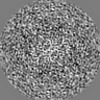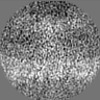[English] 日本語
 Yorodumi
Yorodumi- EMDB-48113: Type B receptor-like particle on the postsynaptic membrane of syn... -
+ Open data
Open data
- Basic information
Basic information
| Entry |  | |||||||||
|---|---|---|---|---|---|---|---|---|---|---|
| Title | Type B receptor-like particle on the postsynaptic membrane of synaptosomes | |||||||||
 Map data Map data | ||||||||||
 Sample Sample |
| |||||||||
 Keywords Keywords | Synaptosome / Postsynaptic / Receptor-like / Excitatory synapse / MEMBRANE PROTEIN | |||||||||
| Biological species |  | |||||||||
| Method | subtomogram averaging / cryo EM / Resolution: 26.0 Å | |||||||||
 Authors Authors | Rong S / Qiangjun Z | |||||||||
| Funding support |  United States, 2 items United States, 2 items
| |||||||||
 Citation Citation |  Journal: J Cell Biol / Year: 2025 Journal: J Cell Biol / Year: 2025Title: The postsynaptic density in excitatory synapses is composed of clustered, heterogeneous nanoblocks. Authors: Rong Sun / James P Allen / Zhuqing Mao / Liana Wilson / Mariam Haider / Baris Alten / Zimeng Zhou / Xinyi Wang / Qiangjun Zhou /  Abstract: The nanoscale organization of proteins within synapses is critical for maintaining and regulating synaptic transmission and plasticity. Here, we used cryo-electron tomography (cryo-ET) to directly ...The nanoscale organization of proteins within synapses is critical for maintaining and regulating synaptic transmission and plasticity. Here, we used cryo-electron tomography (cryo-ET) to directly visualize the three-dimensional architecture and supramolecular organization of postsynaptic components in both synaptosomes and synapses from cultured neurons. Cryo-ET revealed that postsynaptic density (PSD) is composed of membrane-associated nanoblocks of various sizes. Subtomogram averaging from synaptosomes showed two types (type A and B) of postsynaptic receptor-like particles at resolutions of 24 and 26 Å, respectively. Furthermore, our analysis suggested that potential presynaptic release sites are closer to nanoblocks with type A/B receptor-like particles than to nanoblocks without type A/B receptor-like particles. The results of this study provide a more comprehensive understanding of synaptic ultrastructure and suggest that PSD is composed of clustering of various nanoblocks. These nanoblocks are heterogeneous in size, assembly, and distribution, which likely contribute to the dynamic nature of PSD in modulating synaptic strength. | |||||||||
| History |
|
- Structure visualization
Structure visualization
| Supplemental images |
|---|
- Downloads & links
Downloads & links
-EMDB archive
| Map data |  emd_48113.map.gz emd_48113.map.gz | 1.5 MB |  EMDB map data format EMDB map data format | |
|---|---|---|---|---|
| Header (meta data) |  emd-48113-v30.xml emd-48113-v30.xml emd-48113.xml emd-48113.xml | 12.2 KB 12.2 KB | Display Display |  EMDB header EMDB header |
| FSC (resolution estimation) |  emd_48113_fsc.xml emd_48113_fsc.xml | 3.6 KB | Display |  FSC data file FSC data file |
| Images |  emd_48113.png emd_48113.png | 24.3 KB | ||
| Filedesc metadata |  emd-48113.cif.gz emd-48113.cif.gz | 3.8 KB | ||
| Others |  emd_48113_half_map_1.map.gz emd_48113_half_map_1.map.gz emd_48113_half_map_2.map.gz emd_48113_half_map_2.map.gz | 2 MB 2 MB | ||
| Archive directory |  http://ftp.pdbj.org/pub/emdb/structures/EMD-48113 http://ftp.pdbj.org/pub/emdb/structures/EMD-48113 ftp://ftp.pdbj.org/pub/emdb/structures/EMD-48113 ftp://ftp.pdbj.org/pub/emdb/structures/EMD-48113 | HTTPS FTP |
-Validation report
| Summary document |  emd_48113_validation.pdf.gz emd_48113_validation.pdf.gz | 813.4 KB | Display |  EMDB validaton report EMDB validaton report |
|---|---|---|---|---|
| Full document |  emd_48113_full_validation.pdf.gz emd_48113_full_validation.pdf.gz | 813 KB | Display | |
| Data in XML |  emd_48113_validation.xml.gz emd_48113_validation.xml.gz | 9.4 KB | Display | |
| Data in CIF |  emd_48113_validation.cif.gz emd_48113_validation.cif.gz | 12.2 KB | Display | |
| Arichive directory |  https://ftp.pdbj.org/pub/emdb/validation_reports/EMD-48113 https://ftp.pdbj.org/pub/emdb/validation_reports/EMD-48113 ftp://ftp.pdbj.org/pub/emdb/validation_reports/EMD-48113 ftp://ftp.pdbj.org/pub/emdb/validation_reports/EMD-48113 | HTTPS FTP |
-Related structure data
- Links
Links
| EMDB pages |  EMDB (EBI/PDBe) / EMDB (EBI/PDBe) /  EMDataResource EMDataResource |
|---|
- Map
Map
| File |  Download / File: emd_48113.map.gz / Format: CCP4 / Size: 3.4 MB / Type: IMAGE STORED AS FLOATING POINT NUMBER (4 BYTES) Download / File: emd_48113.map.gz / Format: CCP4 / Size: 3.4 MB / Type: IMAGE STORED AS FLOATING POINT NUMBER (4 BYTES) | ||||||||||||||||||||||||||||||||||||
|---|---|---|---|---|---|---|---|---|---|---|---|---|---|---|---|---|---|---|---|---|---|---|---|---|---|---|---|---|---|---|---|---|---|---|---|---|---|
| Projections & slices | Image control
Images are generated by Spider. | ||||||||||||||||||||||||||||||||||||
| Voxel size | X=Y=Z: 3.3 Å | ||||||||||||||||||||||||||||||||||||
| Density |
| ||||||||||||||||||||||||||||||||||||
| Symmetry | Space group: 1 | ||||||||||||||||||||||||||||||||||||
| Details | EMDB XML:
|
-Supplemental data
-Half map: #1
| File | emd_48113_half_map_1.map | ||||||||||||
|---|---|---|---|---|---|---|---|---|---|---|---|---|---|
| Projections & Slices |
| ||||||||||||
| Density Histograms |
-Half map: #2
| File | emd_48113_half_map_2.map | ||||||||||||
|---|---|---|---|---|---|---|---|---|---|---|---|---|---|
| Projections & Slices |
| ||||||||||||
| Density Histograms |
- Sample components
Sample components
-Entire : Type B receptor-like particle on the postsynaptic membrane of syn...
| Entire | Name: Type B receptor-like particle on the postsynaptic membrane of synaptosomes |
|---|---|
| Components |
|
-Supramolecule #1: Type B receptor-like particle on the postsynaptic membrane of syn...
| Supramolecule | Name: Type B receptor-like particle on the postsynaptic membrane of synaptosomes type: complex / ID: 1 / Parent: 0 |
|---|---|
| Source (natural) | Organism:  |
-Experimental details
-Structure determination
| Method | cryo EM |
|---|---|
 Processing Processing | subtomogram averaging |
| Aggregation state | particle |
- Sample preparation
Sample preparation
| Buffer | pH: 7.4 |
|---|---|
| Vitrification | Cryogen name: ETHANE |
- Electron microscopy
Electron microscopy
| Microscope | TFS KRIOS |
|---|---|
| Image recording | Film or detector model: GATAN K3 BIOQUANTUM (6k x 4k) / Average electron dose: 2.5 e/Å2 |
| Electron beam | Acceleration voltage: 300 kV / Electron source:  FIELD EMISSION GUN FIELD EMISSION GUN |
| Electron optics | Illumination mode: FLOOD BEAM / Imaging mode: BRIGHT FIELD / Nominal defocus max: 2.0 µm / Nominal defocus min: 2.0 µm |
| Experimental equipment |  Model: Titan Krios / Image courtesy: FEI Company |
 Movie
Movie Controller
Controller




 Z (Sec.)
Z (Sec.) Y (Row.)
Y (Row.) X (Col.)
X (Col.)





































